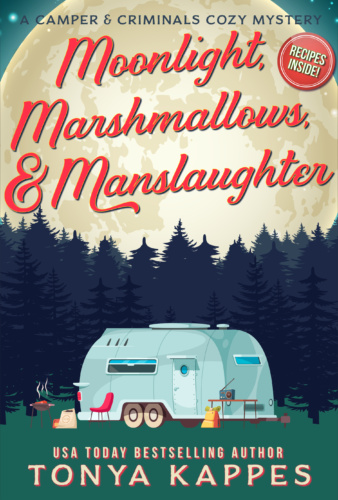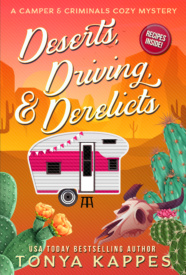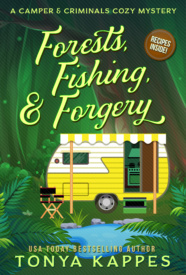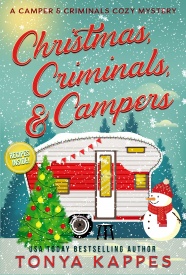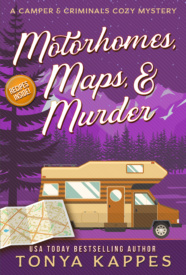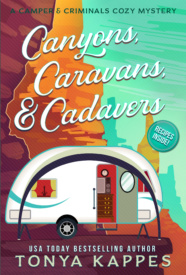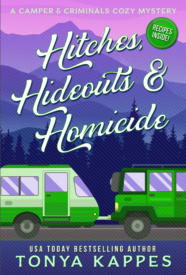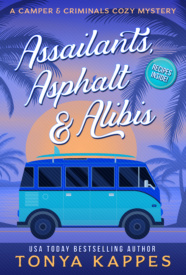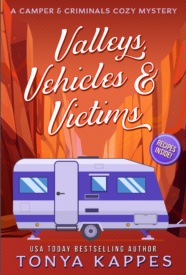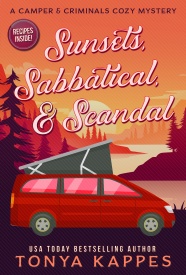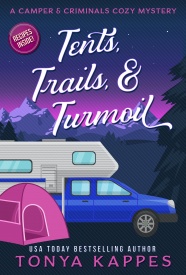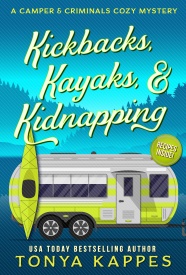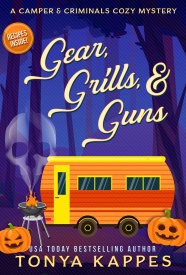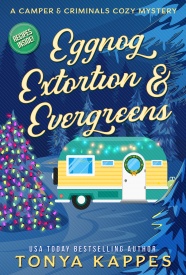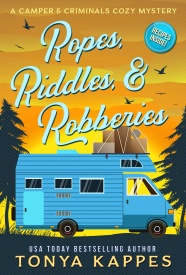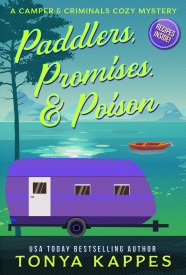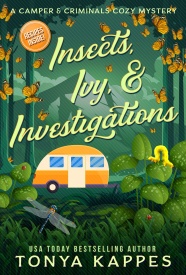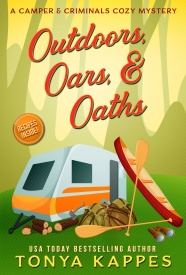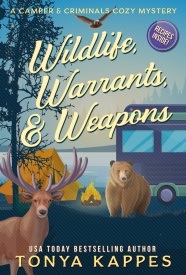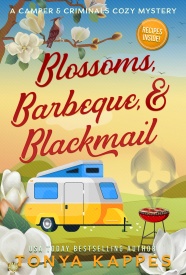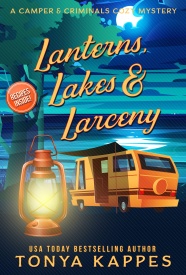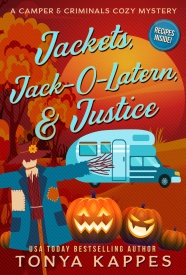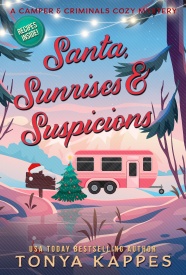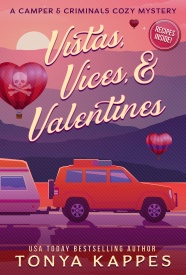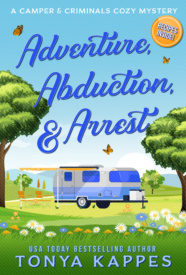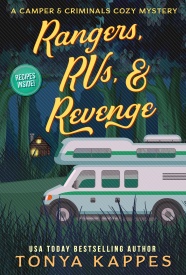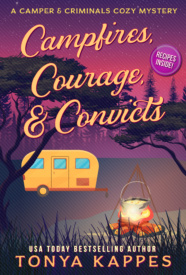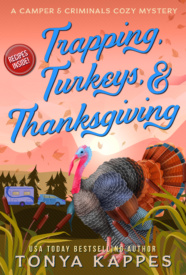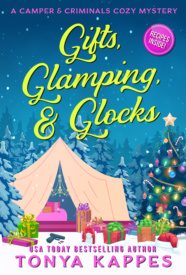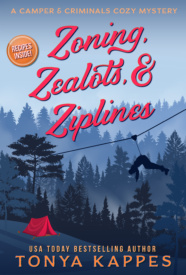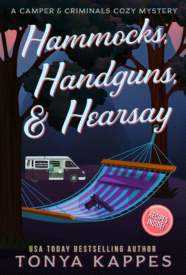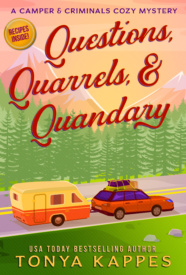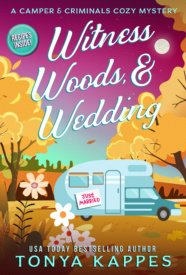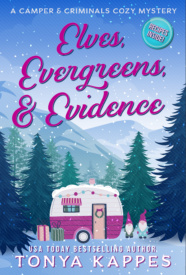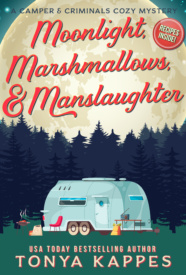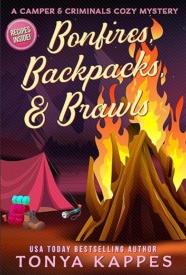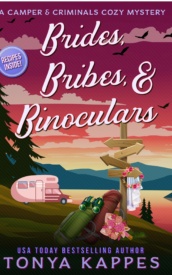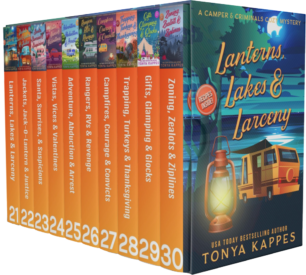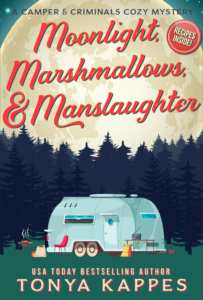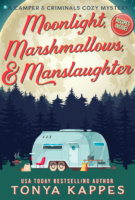Moonlight, Marshmallows, & Manslaughter
Book 35 in the Camper & Criminals Cozy Mystery Series
Welcome to Normal, Kentucky, where the only thing normal is the unexpected! Join Mae West and the Laundry Club Ladies as they untangle a mystery as intriguing as the winding paths of Daniel Boone National Forest.
During National Wildflower Week, Normal is abuzz with nature enthusiasts and botanists. But the festivities take a dark turn when a renowned botanist known for her groundbreaking research is found dead under the moonlit sky. The tranquil celebration is shattered, and the town is gripped with shock and disbelief.
The trails may have gone cold, but Mae and her friends are hot on the case. From a land developer with a not-so-clear conservation plan to an assistant whose obsession takes a dangerous turn, the list of suspects is as diverse as the town’s flora. Mae delves into a thicket of hidden motives and secrets, discovering that danger in Normal can sprout up unexpectedly.
Navigating through a labyrinth of environmental politics and hidden agendas, the Laundry Club Ladies are determined to expose the truth and bring justice. But in Normal, where the extraordinary often lurks beneath the surface, can Mae piece together the puzzle before the killer strikes again?
“Moonlight Marshmallows & Manslaughter” invites you on a captivating journey through the heart of Kentucky. It’s a cozy mystery that intertwines the charm of small-town life with the thrill of the unknown. So, get ready to be immersed in a tale where uncovering the truth is as vital as preserving the beauty of nature itself.
Read an Excerpt
Moonlight, Marshmallows, & Manslaughter
Excerpt
Jump to Ordering Options ↓
Chapter One
The full moon cast a silver glow over the Daniel Boone National Forest, turning the night into a canvas of shadow and light. It was a perfect setting for the midnight tour Queenie French was giving in honor of National Wildflower Week.
Queenie volunteered at the Daniel Boone National Historical Society for years before she’d been given the presidential task, a duty she took on proudly.
By rights too.
She could tell you everything there was to know about the Daniel Boone National Forest, and that included every single piece of foliage that grew among the trees. Her knowledge was what made her the perfect guide for the moonlight trail hike, where most of the participants on the tour were here to see one very rare bloom.
Night-blooming trilliums.
As a favor to Queenie, one of my best friends, I—along with the rest of the members of our very exclusive Laundry Club Ladies, Betts Hager, Abby Fawn Bonds, and Dottie Swaggert— decided to forgo any sort of beauty sleep to help Queenie with her tour as the anchors of the group.
As the last of the group, it was our job to make sure no one strayed away or, worse, fell off the cliffs running along both sides of the trail.
Since I was a member of the National Park Committee, I knew most of the trails in our little area of the Daniel Boone National Forest like the back of my hand. After all, my small part in this whole big seven hundred thousand acres of trees was to test out and even find new trails we could add to the forest’s already vast map.
And from what I could tell by how long we had walked, as well as from a few of the identifying markers, we were pretty close to the very rare wildflower we were here to see.
Queenie French’s headband light bobbed up ahead like a beacon in the sea of darkness. The air was thick with the scent of wildflowers and pine, and the chorus of nocturnal creatures provided a natural soundtrack to our moonlit adventure.
Queenie’s voice, bright and cheerful, carried over the group as she pointed out a patch of rare night-blooming trilliums. The tourists, a mix of locals and out-of-towners, hung on her every word, their flashlights dancing over the forest floor.
As we trailed behind the group, I couldn’t help but admire the serene beauty of the night around us. The moon’s glow seemed to breathe life into the forest, casting long, dancing shadows among the trees.
It’d been a long winter, and though it was cold and snowy, the forest held a dormant, silent beauty under its blanket of white.
Now, with the arrival of spring, the air was filled with a sense of renewal and life. The warmer nights had awakened the slumbering woods, bringing with them the sweet aroma of budding flowers and the soft rustling of new leaves. The trees, once stark and bare, now stood tall with the promise of lush greenery, their branches swaying gently in the breeze, as if stretching after their long winter’s nap.
The forest floor, hidden for months under snow, now teemed with sprouting plants, painting the landscape in vibrant hues of green and bursts of wildflower colors. This transformation from the starkness of winter to the vitality of spring was a marvel to behold, adding to the magic of our moonlit walk.
Up ahead, Queenie stopped suddenly, causing a ripple of curiosity in the group. Her headband light focused on a small cluster of flowers nestled in the underbrush.
“Everyone, gather round.” She beckoned with a sweep of her hand, her voice tinged with excitement. “You’re in for a real treat.”
The group congregated around her, their faces illuminated by the soft, eerie glow of her light.
“These,” Queenie began, her finger delicately tracing the air just above the flowers, “are night-blooming trilliums, a rare and beautiful sight. They only bloom under the light of the full moon.”
Murmurs of awe rippled through the group as flashlights and phones were raised to capture the moment. The flowers, with their three delicate white petals, seemed to glow ethereally in the darkness.
Queenie continued, her voice a blend of reverence and pride.
“Local legend has it that these flowers were used by Native Americans for medicinal purposes and were considered a symbol of good fortune. During National Wildflower Week, we’re lucky to witness their bloom. It’s a rare coincidence that aligns with the full moon tonight.”
The tourists were enraptured, hanging onto every word. I glanced at Betts, who shared my smile. It was moments like these that made our little adventures worthwhile.
I couldn’t help but let out a quiet chuckle, reflecting on the behind-the-scenes intricacies of these tours. As a member of the National Park Committee for the Daniel Boone National Park, I had a unique perspective on the elaborate tapestry of regulations and permissions that wove together each event in this sprawling forest. Securing permits for festival weeks or special occasions was a detailed process, one that involved meticulous planning and a keen awareness of environmental impact.
This was especially true for National Wildflower Week, an event that always drew a diverse crowd, from botanical enthusiasts to conservationists. It was a delicate balance, managing the influx of visitors eager to witness the natural splendor while ensuring the preservation of this precious ecosystem. Tensions sometimes ran high, with different botanical organizations converging on the area, each with their own passionate views on land conservation.
Moreover, these events often attracted protesters, groups adamant in their belief that the land should remain untouched, a sanctuary free from human interference.
Their presence added a layer of complexity to the proceedings, as we strove to honor their concerns while celebrating the beauty of nature that brought us all together. In these moments, the forest became not just a backdrop for natural beauty, but a stage for the unfolding drama of humans’ and nature’s coexistence.
But just for tonight and at this late hour, it was refreshing to see us all come together and enjoy what the forest had to offer underneath the blanket of stars.
Just as the group prepared to move on, a faint rustling from the nearby bushes caused a few startled jumps. Queenie, ever the professional, laughed lightly.
“Just a small critter, folks. We have plenty of those in the forest. Nothing to worry about.” Her words put some relief on the faces I could make out from the moonlight since she’d literally scared the pants off them at the beginning of the tour when she told them all about the black bear population and how active they could be at night during the spring season.
The group’s attention returned to the path ahead. Little did we know, the night was about to take a turn that none of us could have predicted, leading us down a trail far more mysterious than any we had walked before.
Betts, Abby, Dottie, and I slowly walked behind them, catching a few more oohs and aahs from the tourists as we passed by the rare flower Queenie had shown them. They snapped photos with the very large cameras that hung around their necks, the flashes lighting up the darkness in their attempts to photograph the midnight blooms that would soon close as the dawn approached the forest.
As we continued along the moonlit trail, a murmur of voices caught my ear.
A couple had stopped walking the trail and was focused solely on the flowers, engaged in what appeared to be a hushed but heated debate.
I recognized them immediately as Dr. Emily Grayson and Marshall Robins. Both of them had come in front of the committee to propose different workshops to be held during this week’s celebration of National Wildflower Week.
Dr. Emily Grayson, a renowned botanist with an infectious passion for wildflowers, had presented a compelling case for her workshop. Her goal was to educate the public about the importance of preserving native species, particularly those at risk. Her enthusiasm was palpable, her knowledge extensive, and her dedication to environmental conservation evident in every word she spoke.
Marshall Robins, on the other hand, approached the committee with a different agenda. As a representative of a prominent real estate development company, his workshop was designed to discuss the balance between development and nature conservation. He emphasized sustainable practices, but there was an underlying current of tension, especially when his plans intersected with protected areas known for their natural beauty and ecological significance.
Their presence here, amidst the serene backdrop of the Daniel Boone National Forest, was a stark reminder of the ongoing struggle between conservation and development. The two held strong, opposing views, making their collaboration for National Wildflower Week both surprising and a subject of local intrigue.
As I watched them argue beside the rare night-blooming trilliums, I couldn’t help but wonder if their debate was about more than just the flowers. There was a history of subtle conflict between them, a clash of ideals that often sparked intense discussions. Emily’s dedication to preserving nature often put her at odds with Marshall’s development plans, and it was common knowledge that their professional relationship was strained at best.
Their argument tonight, however heated, seemed to be just another chapter in their ongoing battle. Yet, as I observed them from a distance, a nagging feeling tugged at me. In a town like ours, where secrets often lurked just beneath the surface, I had learned that such confrontations could sometimes be a prelude to something more sinister.
Their gestures were animated, their expressions a mix of frustration and exasperation, as they discussed the rare night-blooming trilliums we had just admired.
We all sorta stopped a little farther back so we didn’t get into the middle of an argument that appeared to be heating up.
“We” as in Betts, Abby, and me.
Not Dottie.
At first, she seemed oblivious to the couple’s presence before she stopped just a few paces behind them.
Her fiery red hair, free of its usual pink foam curlers, seemed almost ablaze under the moonlight. Clad in khaki shorts, a neatly tucked in white shirt, and flip-flops—despite my earlier insistence on hiking boots—Dottie was a picture of unapologetic individualism. She had a cigarette casually resting on her lip, unlit but ready for the moment she stepped off the trail.
“Did you hear that?” Dottie asked, jerking back to us, her tone laced with disbelief and a hint of amusement.
She had overheard a fragment of the heated exchange between Dr. Emily Grayson and Marshall Robins, who now trailed behind the group, embroiled in their own world of conflict.
“If that’s the kind of judgment you apply to your botanical research, Emily, then maybe you should consider a different field altogether.” Marshall’s voice, sharp and critical, cut through the night air.
The moon seemed to shine right down on Dr. Grayson, her face a mix of shock and indignation, as she retorted something inaudible, her hands gesturing wildly in frustration.
Dottie, catching the gist of their argument, hurried back toward us. I could tell she was itching to spill the gossip.
“If that boy’s brains were dynamite, he couldn’t blow his nose.” She chuckled, the sound muffled by the night. “Seems like Mr. Robins’s words are ugly enough to blister a mule’s butt from forty paces.”
“What are they talking about?” Betts asked.
“Talkin’?” Dottie’s head slightly pulled back. “You mean fightin’, and I don’t mean a simple argument.”
As an anchor of the tour, I knew we needed to keep things moving, and the only way to do that was to continue walking, to get closer so they would need to move along.
The couple’s argument seemed to simmer down as they saw us approach, making them hurry to catch up with the rest of the group. But their flushed faces didn’t go unnoticed as I could tell there were still remnants of their quarrel.
As the tour progressed, the argument between Dr. Emily Grayson and Marshall Robbins didn’t die down like I thought it might. It escalated.
Their voices carried through the night and echoed through the tour group. Queenie didn’t stop the tour, but the people in front of Emily and Marshall turned to see what it was all about.
I couldn’t help but overhear snippets of the heated conversation, and I could tell from the way Abby’s and Bett’s faces contorted, they, too, heard some really awful things.
“You’re endangering the very essence of what makes these wildflowers and our natural habitats precious.” Emily’s voice was sharp, her words pointed like arrows. “People coming to Normal for National Wildflower Week care about genuine conservation, not the lip service paid by developers who prioritize profit over the environment.”
Even under the dark sky, I could see Marshall’s face reddened with a mix of anger and indignation.
“Watch your words, Emily,” he spat back, his tone icy. “This festival brings in all sorts, and not everyone shares your radical views. Some of your so-called supporters might have a different perspective. Be careful not to push too hard.”
The tension between them was thick, and it was clear that their argument was about more than just wildflowers—it was a clash of ideals, a battle between preservation and profit.
It wasn’t anything new when we hosted such events. And honestly, even though the National Park Committee had tried to make it a fun and unique experience, there were just going to be folks who didn’t see eye to eye.
Like these two, and no matter what the cost, they were going to argue even though neither was going to come to see the other’s point of view.
It had to be exhausting. I shook my head and rolled my eyes just as Marshall turned on his heel and stalked off, his headlamp bobbing violently as he rejoined the front of the tour group. The rest of us exchanged glances, sensing the gravity of their exchange.
Before he was about to disappear into the darkness, Marshall turned slightly, his headlamp casting a stark light on his face. His lips, stiff with anger, formed a warning that sent a chill down my spine.
“Don’t do something you’re going to regret, Emily,” he called out into the night, his voice echoing through the trees.
As he vanished from sight, a heavy silence settled over us. The usual sounds of the forest seemed to pause, as if nature itself was holding its breath.
Betts leaned in close, her expression a mix of concern and curiosity. “Something tells me we haven’t heard the last of that,” she murmured.
I nodded in agreement, not sure what they were fighting about, but I didn’t care. He had said some really mean things, and as a committee member, I felt it was my job to make sure she was okay.
After Marshall stormed off, the whole place went quiet for a bit. It felt like even the woods were holding their breath. The path we were on was pretty rugged, with rocks and dirt that made walking a bit tricky. I could hear small animals rustling around in the bushes, adding to the spooky vibe of the night.
Up ahead, Queenie was still going on about some other rare flower, her voice drifting back to us. But my mind was stuck on what just happened between Emily and Marshall. By the way Emily had pulled back and walked with her head slightly pointed toward the ground, not appearing to be listening to Queenie, I could tell she, too, was bothered by what had gone on between them.
I walked up to Dr. Grayson, who seemed lost in thought, probably replaying that argument in her head.
“Dr. Grayson, you good?” I asked, trying to sound as friendly as I could.
She turned to me, the light from someone’s flashlight catching her face.
“Oh, Mae.” She recalled my name after it dawned on her how we’d met at the many committee meetings. “I… I’m fine, I guess. Just a bit shaken up,” she replied, trying to smile but not quite making it.
I nodded, understanding how she felt. “That was quite a spat you two had. Anything serious?”
She hesitated for a moment then said, “It’s about the land development Marshall is pushing. You know, the one he’s calling a ‘conservation project’? Well, it’s right where those rare trilliums are. If his plan goes through, those flowers, and a whole lot of other stuff, could be gone for good.”
My ears perked up at that. This was big news to me and nothing he’d submitted to the committee.
If Marshall’s project threatened those rare flowers, it could mean trouble. Marshall’s project had been touted as good for the environment, but if it was actually harmful, that was something I was going to have to look into in the morning.
“By the look on your face, I can tell some of his paperwork might not have mentioned all that,” she said. “And that’s why I told him I was going to go back to your offices and talk to Judge Hemmer.”
Judge Hemmer was the president of the committee, and he’d know for sure what Marshall had submitted and had not, which made it much better for me if Emily was going to go look into it so I didn’t have to worry myself with it.
There was no way Gab Hemmer was going to let anything bad happen to the forest. I was sure about that.
“I’m not on the actual subcommittee for those types of things dealing with the forest, so I would definitely say you should go straight to Gab if you have knowledge the paperwork Marshall submitted was incorrect. Plus, there’d be all sorts of drawings along with a lot of other people who have their hands in it to make sure nothing is disturbed,” I said, assuring her nothing was going to be done that wasn’t aboveboard. I didn’t want to bore her with the details about all the groups and engineers involved in something as big as what Marshall had proposed.
“Unless some of those bigger institutions have their hand in someone’s wallet.” She smirked.
“Thanks, Emily,” I said, my brain already racing with the possibilities. “That’s really important to know.”
As we walked on, following the trail and Queenie’s voice, I kept thinking about what Emily said. This was more than just a squabble over a project. This was about protecting the beauty of our forest.
“What did you say to her?” Dottie asked after I lingered a little to let Emily fall in line with the tour group.
“Nothing that’s important as of right now,” I said, not telling Dottie or the rest of the Laundry Club Ladies since there was nothing to tell.
Yet.


